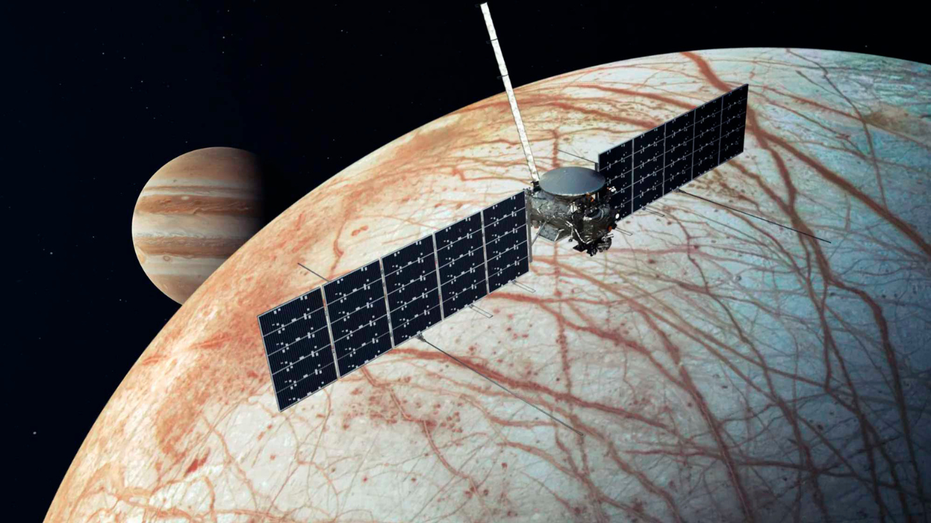
NASA’s Europa Clipper: A Mission to Uncover Life-Sustaining Secrets Beneath Jupiter’s Icy Moon
A new frontier in the quest for extraterrestrial life is about to be explored as NASA’s Europa Clipper spacecraft embarks on a groundbreaking journey to Jupiter’s enigmatic moon, Europa. This mission holds immense promise for discovering whether the conditions necessary for life exist beyond our planet.
Peering Beneath the Ice
Scheduled for launch this month aboard SpaceX’s Falcon Heavy rocket from NASA’s Kennedy Space Center, the Europa Clipper will take a closer look at the moon’s icy exterior. Scientists believe that beneath Europa’s thick ice crust, which is estimated to be between 10 to 15 miles deep, lies a vast ocean that could be up to 80 miles deep. While the Clipper won’t directly search for life, it will analyze whether the environment could potentially support it.
“This mission allows us to explore a world that might be habitable today, not just one that could have been billions of years ago,” explains Curt Niebur, the program scientist behind this ambitious endeavor.
A Closer Encounter
The Europa Clipper is notable for its size and capabilities. With its expansive solar panels, the spacecraft measures about the length of a basketball court, nearly 100 feet from end to end, and weighs around 13,000 pounds. Upon its arrival at Jupiter in 2030, it will perform a series of close flybys, coming within just 16 miles of Europa’s surface—much closer than any previous missions.
The mission is expected to last several years, culminating with a planned crash into Ganymede, Jupiter’s largest moon, in 2034. With a total journey of 1.8 billion miles, the Clipper will utilize gravity assists from Mars and Earth to boost its trajectory.
What Lies Beneath: The Search for Habitability
Europa has long fascinated scientists because of its potential to harbor life. The moon is believed to contain not only water but also organic compounds essential for life as we know it. Thermal vents on the ocean floor could serve as a potential energy source for any microbial life forms that might exist in Europa’s depths.
Bonnie Buratti, the deputy project scientist, suggests that if life does exist on Europa, it would likely resemble primitive bacteria found in Earth’s deep ocean vents. “We will not know from this mission because we can’t see that deep,” she adds. The Clipper’s primary focus will be to determine whether the moon could support life, either in its ocean or in pockets of water trapped within the ice.
Guarding Against Radiation
Jupiter’s formidable radiation environment presents a significant challenge for the Europa Clipper. The moon passes through intense radiation belts, which could be detrimental to the spacecraft’s electronics. To combat this, Clipper’s sensitive components are housed within a protective vault made of dense aluminum and zinc, ensuring they can withstand the harsh conditions of space.
After initial concerns that the spacecraft’s transistors might not endure the radiation levels, engineers conducted extensive analyses and confirmed that the mission would proceed as planned.
A Legacy of Exploration
This mission follows a legacy of exploration of Jupiter and its moons, beginning with the Pioneer spacecraft in the 1970s. The Voyager missions captured the first detailed images of Europa, and NASA’s Galileo spacecraft conducted multiple flybys in the 1990s. Currently, the Juno spacecraft continues to gather invaluable data about the gas giant and its moons.
In addition to Europa, other moons such as Ganymede and Callisto are also believed to potentially harbor subsurface oceans. The European Space Agency’s Juice spacecraft, arriving at Jupiter shortly after Clipper, will further investigate these intriguing worlds.
Messages from Earth
As part of its mission, the Europa Clipper carries a unique message for any potential life it may encounter. Attached to its electronics vault is a triangular metal plate featuring the word for “water” in 104 different languages and a poem about the moon by U.S. poet laureate Ada Limon. Additionally, a silicon chip containing the names of 2.6 million individuals who signed up to be part of this historic journey is included.
As the Europa Clipper sets off on its ambitious mission, it stands at the forefront of humanity’s quest to uncover the mysteries of life beyond our planet, promising exciting discoveries in the years to come.

